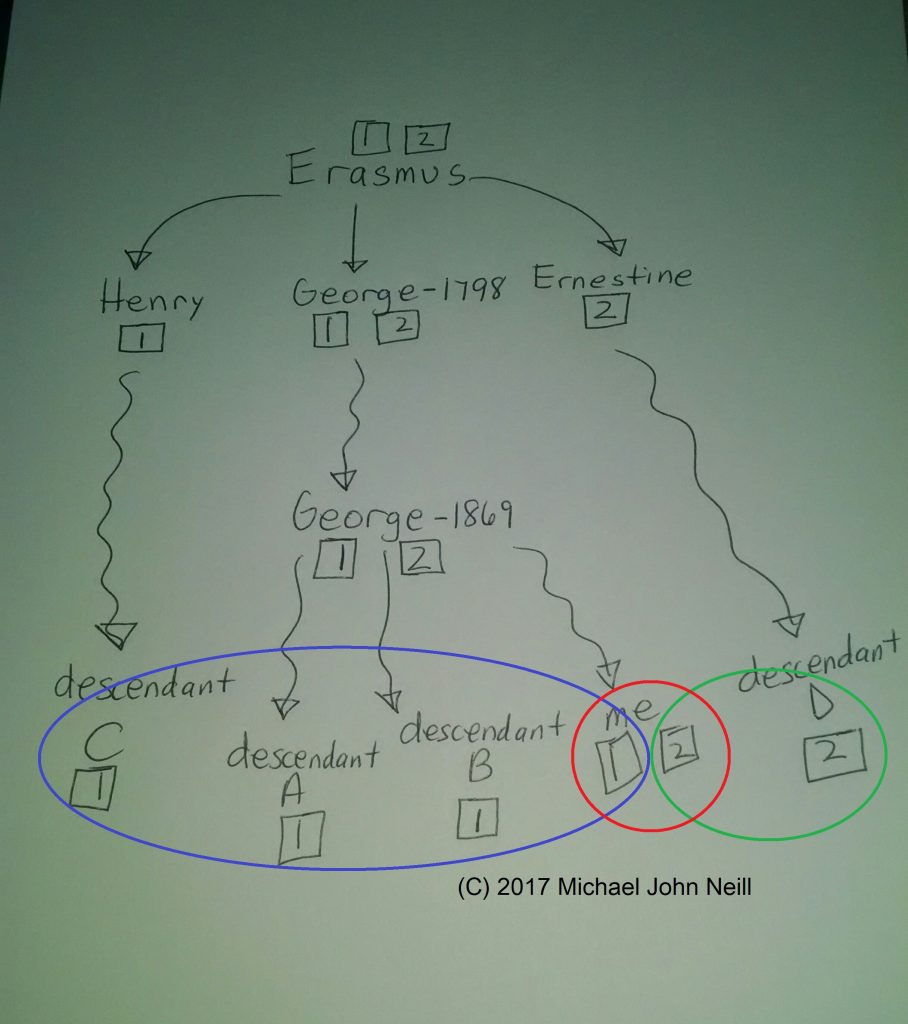I’ve changed the names of the submitters to protect their identify.
A, B, C, D, and I descend from Erasmus Trautvetter, born about 1770 in Thuringen, Germany. His descendants are documented in an 1870-era estate settlement in Hancock County, Illinois, and in church records in Thuringen. A, B, and I all descend from Erasmus’ great-grandson George Trautvetter (1869-1934) and his wife Ida Sargent (1874-1939) through Erasmus’ son also named George (born 1798). C and D descend from two different children of Erasmus.
We’ve all tested at AncestryDNA. A and B and I are relatively close matches (to be expected given our relationship). C and D were more distant matches to me.
The matches that I shared with A, B, C, and D are as follows:
A–shares B and C with me
B–shares A and C with me
C–shares A and B with me
D–shares nothing else with me
On the surface that may seem strange. All of us are descendants of the same couple and yet there are two “pools” of descendants: A, B, C and me…and D and me.
We’re going to simplify things just a little bit to make the visual easier to see.
The most likely scenario stems from the fact that all of us do not inherit the same genetic material from our parents. After all, we receive half our DNA from our mother and half from our father. We can’t get a complete set from each. Those who share grandparents will not have the exact same set of DNA from those grandparents. There will be pieces that they share, but they will not have the exact same set of DNA from each grandparents–there will be differences.
At the risk of oversimplifying, let’s just concentrate on two pieces of Erasmus’ DNA. We will call one piece 1 and the other piece 2. Son Henry only received piece 1. George received pieces 1 and 2. Daughter Ernestine only received piece 2.
Piece 1 passes to Henry’s descendant we are calling descendant C.
Piece 2 passes to Ernestine’s descendant we are calling descendant D.
Pieces 1 and 2 pass to son George’s descendant George (born in 1869). For some reason, George (born 1869)’s descendants A and B only received piece 1. George (born 1869)’s other descendant (me) received piece 1 and 2. I got the lucky DNA.
That’s why A, B, C and I match and why D and I match, but why we all don’t match each other. It’s because we all don’t share the same DNA. It’s also remotely possible that D and I are related on a non-Trautvetter line, but since D and I share no other matches that doesn’t seem likely.

5 Responses
Thanks for the explanation . It really helps to explain why you can be related but not have a 100% match in DNA, especially to those who are looking at DNA from a mathematical perspective rather than a genealogical one.
Ah the fun of working with autosomal DNA. 🙂
This is true. 😉
Thanks for sharing this information. I have taken my family DNA twice: once through FTDNA and the other Ancestry (thanks to reduced prices.) My father and all of his Mostert ancestors were born and lived in the Netherlands until my grandfather Mostert brought the family to the US. FTDNA listed me as almost all English, Scot and Irish with no mention of Dutch or any Western Europe. Ancestry divided the Western Europe (Dutch) with English, Scot and Irish.
For a while there I thought my mother had been playing around before I was born, although I found that terribly hard to believe. Is this something you might address some time.
I enjoy your writing and have subscribed to this service for many years. Back in the ’60s and 70s I lived with my wife and are five children in Quincy. I was an announcer on WTAD Radio and did news, weather and sports as Andy Lowe on KHQA-TV. Later for four years I managed a non-profit program helping people in Adams, Hancock, Schuyler, Brown and Pike Counties get training and jobs funded by the federal government through the Illinois State Department of Manpower and Human Development. I managed similar programs in Champaign for 18 years and for five more in Springfield before I retired.
Andre J. Mostert
Thanks for your note. It is indeed a small world.
The ethnic ancestry at Ancestry.com is something of a guess and I consider it to be mostly entertainment. It shows me as 57& British–which is odd since nearly 3/4 of my ancestry is German and documented back to at least the late 1700s.
Michael